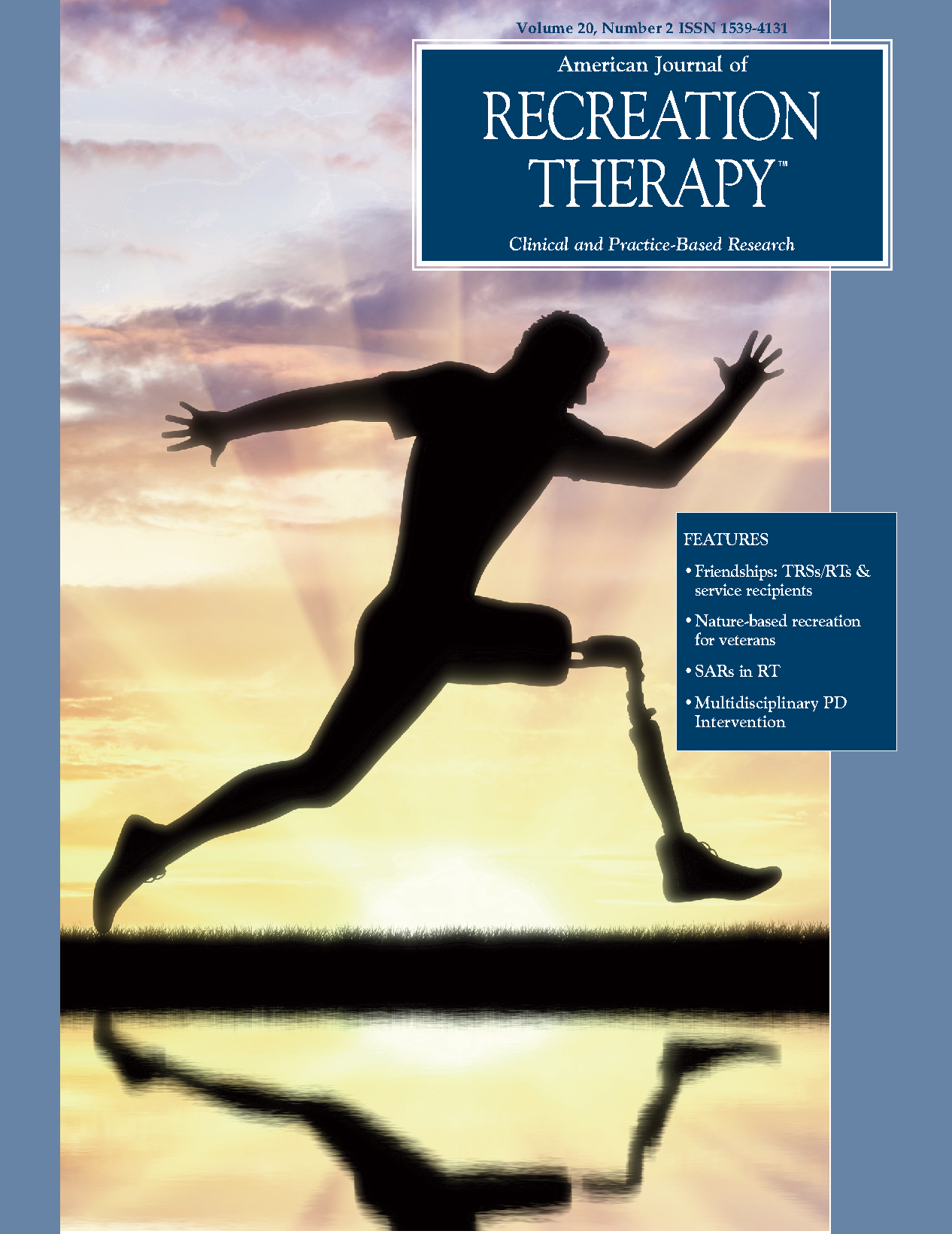Effects of recreational therapy and speech therapy among participants with Parkinson disease and Parkinson plus conditions: Findings from a 16-week multidisciplinary program
DOI:
https://doi.org/10.5055/ajrt.2021.0235Keywords:
Parkinson disease, Parkinson plus conditions, speech therapy, recreational therapy, multidisciplinary programAbstract
Idiopathic Parkinson disease (IPD) affects multiple aspects of a person’s daily functioning. The current study examined the effects of a multidisciplinary intervention program, including recreational therapy (RT) and speech therapy, among individuals with IPD or PD plus conditions over 16 weeks. The study included six participants with IPD and a participant with progressive supranuclear palsy (PD plus condition). Participants with IPD attended a weekly LOUD Crowd® program consisting of different speech and cognitive activities. In addition, all seven participants attended an RT intervention focusing on fall prevention education and implementing balance, strength, and endurance routines. Results indicated improvements in dynamic balance, reduced fall risk, cognition, swallowing, and voice-related outcomes. In conclusion, a multidisciplinary intervention program is beneficial for individuals with PD or PD plus conditions.
References
Olanow CW, Stern MB, Sethi K: The scientific and clinical basis for the treatment of Parkinson disease. Neurology 2009; 72(4): S1-S136.
Miller N: Utility and accuracy of perceptual voice and speech distinctions in the diagnosis of Parkinson’s disease, PSP and MSA-P. Neurodegener Dis Manag. 2017; 7(3): 191-203.
Krysiak A: Language, speech, and communication disorders in Parkinson’s disease. Neuropsychiatria I Neuropsychologia 2011; 6(1): 36-42.
Bohlhalter S, Kaegi G: Parkinsonism: Heterogeneity of a common neurological syndrome. Swiss Medi Wkly. 2011; 14l: 1-9.
Magrinelli F, Picelli A, Tocco P, et al.: Pathophysiology of motor dysfunction in Parkinson’s disease as the rationale for drug treatment and rehabilitation. Parkinsons Dis. 2016. Available at https://www.ncbi.nlm.nih.gov/pubmed/27366343. Accessed March 8, 2020.
Pickering RM, Grimbergen YAM, Rigney U, et al.: A meta-analysis of six prospective studies of falling in Parkinson’s disease. Mov Disord. 2007; 22(13): 1892-1900.
Rahman HJ, Griffin NP, Quinn, JM: On the nature of fear of falling in Parkinson’s disease. Behav Neurol. 2011; 24(3): 219-228.
Dontje ML, de Greef MHG, Speelman AD, et al.: Quantifying daily physical activity and determinants in sedentary patients with Parkinson’s disease. Parkinsonism Relat Disord. 2013; 19(10): 878-882.
Levin J, Kurz A, Arzberger T, et al.: The differential diagnosis and treatment of atypical parkinsonism. Dtsch Arztebl Int. 2016; 113: 61-69.
Arena JE, Weigand SD, Whitwell JL, et al.: Progressive supranuclear palsy: Progression and survival. J Neuro. 2016; 263: 380-389.
Progressive Supranuclear Palsy: Mayo Clin. 2020. mayoclinic.org. Available at https://www.mayoclinic.org/diseases-conditions/progressive-supranuclear-palsy/diagnosis-treatment/drc-20355664. Published February 7. Accessed March 8, 2020.
Boutsen F, Park E, Dvorak J, et al.: Prosodic improvements in persons with Parkinson disease receiving SPEAK OUT!® voice therapy. Folia Phoniatr Logop. 2018; 70: 51-58.
Levitt JS: A case study: The effects of the “SPEAK OUT!®” voice program for Parkinson’s disease. Int J Appl Sci Technol. 2014; 4(2): 20-28.
Dibble LE, Addison O, Papa E: The effects of exercise on balance in persons with Parkinson’s disease: A systematic review across the disability spectrum. J Neurol Phys Ther. 2009; 33(1): 14-26.
Keener AM, Paul KC, Folle A, et al.: Cognitive impairment and mortality in a population-based Parkinson’s disease cohort. J Parkinsons Dis. 2018; 8(2): 353-362.
Alcock L, O’Brien TD, Vanicek N: Association between somatosensory, visual and vestibular contributions to postural control, reactive balance capacity and healthy ageing in older women. Health Care Women Int. 2018; 29(12): 1366-1380.
Manchester D, Woolacott M, Zederbauer-Hylton N, et al.: Visual, vestibular and somatosensory contributions to balance control in older adults. J Gerontol. 1989; 44(4): M118-M127.
Granacher U, Gollhofer A, Hortobagyi T, et al.: The importance of trunk muscle strength for balance, functional performance, and fall prevention in seniors: A systematic review. Sports Med. 2013; 43(7): 627-641.
Cohen JT, Manor Y: Swallowing disturbance questionnaire for detecting dysphagia. Laryngoscope. 2011; 121: 1383-1387.
Jenkinson C, Fitzpatrick R, Peto V: Health-related quality- of-life measurement in patients with Parkinson’s disease. Pharmacoeconomics. 1999; 15: 157–165. Available at http://ud4cl8nx8h.search.serialssolutions.com/?sid=Entrez:PubMed&id=pmid:10351189. Accessed March 8, 2020.
Mattis S: The Dementia Rating Scale-2 (DRS-2). Lutz, FL: Psychological Assessment Resources, 2004.
Schoneburg B, Mancini M, Horak F, et al.: Framework for understanding balance dysfunction in Parkinson’s disease. Mov Disord. 2013; 28(11): 1474-1482.
Brouwer B, Walker C, Rydahl S, et al.: Reducing fear of falling in seniors through education and activity programs: A randomized controlled trial. J Am Geriatr Soc. 2003; 51(6): 829-834.
Fuzhong L, Harmer P, Fitzgerald K, et al.: Tai chi and postural stability in patients with Parkinson’s disease. N Engl J Med. 2012; 366: 511-519.
Mhatre PV, Vilares I, Stibb SM, et al.: Wii fit balance board playing improves balance and gait in Parkinson disease. J Phys Med Rehabil. 2013; 5(9): 769-777.
Published
How to Cite
Issue
Section
License
Copyright 2000-2025, Weston Medical Publishing, LLC and American Journal of Recreation Therapy. All Rights Reserved.


